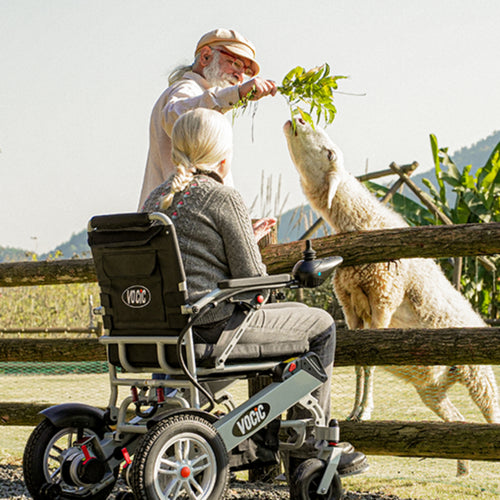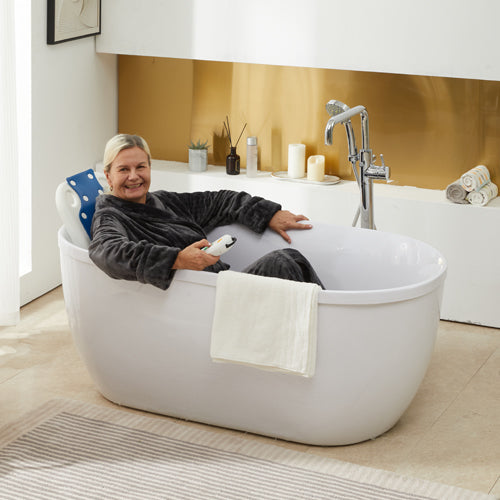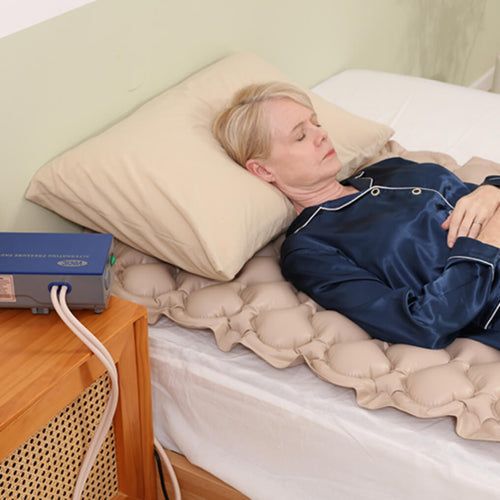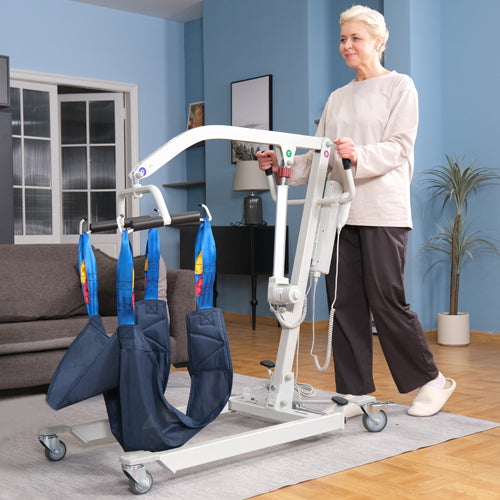For many seniors, everyday walking can become a challenge, making the choice of a mobility aid crucial. Deciding between a rollator and a standard walker can be confusing, as each device supports walking in different ways to meet specific needs and lifestyles.
Let's take a closer look at the specific differences between these two assistive devices to help you decide which one will best suit your mobility needs.
What Is the Rollator Walker?
A rollator (also called a wheeled walker) is a walking aid equipped with wheels—usually three or four—and handgrips, often featuring hand brakes, a built-in seat, and a storage basket.
It is designed for users who need assistance with balance and stability but do not require full weight support, allowing smoother movement without having to lift the device.
Unlike standard walkers, a rollator can glide easily, helping maintain a more natural gait and enabling the user to rest whenever needed. This makes it especially suitable for longer distances and enhances the user’s independence.
What Is the Standard Walker?
A standard walker is a basic mobility aid designed for people who need extra support while walking. It consists of a metal frame and four legs that provide stability. Therefore, the user needs to lift the walker and place it forward with each step, providing stable support. Therefore, they are simple but effective, suitable for indoor use and for people who need a lot of support to maintain balance.
Differences Between a Rollator and a Standard Walker
Choosing between a rollator and a standard walker requires understanding the features of each and how to perform daily activities. Here is a comparison between the two:
-
Mobility and Ease of Use
Rollator: Rolling walkers are designed with four wheels to support the natural rhythm of walking, reducing fatigue because there's no need to lift them, just push. This makes rollators, or walkers with seats for seniors, suitable for those who can walk but get tired easily. They provide relief when traveling long distances or moving around frequently.Standard Walkers: Every movement with a standard walker requires lifting, which ensures stability with each step, but it can be physically demanding. Therefore, it is more suitable for people who are recovering from surgery or have severe mobility impairments and need the highest level of support.
-
Stability and Support
Rollator: Although rolling walkers move smoothly, they require careful control of the wheels and brakes, demanding good hand coordination and strength. Engaging the brakes manually ensures that it does not slide away, providing good stationary support.Standard Walkers: Standard walkers have a sturdy wheel design that provides good support. Every time you put the walker down, it provides a firm, stable base to prevent falls, especially in cluttered environments or uneven surfaces where the wheels may wobble.
-
Features and Accessories
Rollator: Walkers with seats, like rollators, generally come equipped with a seat and sometimes even a small basket or pouch. This setup is ideal for taking breaks during long walks or carrying essentials without needing a separate bag.Standard Walkers: It is a simple device without a roller walker seat, nor does it have storage space, just support. Its simple design means that there is little room for error or adjustment, which is a perfect choice for users who need a reliable support tool but do not need additional maintenance.
-
Applicability
Rollator: Rolled walker can be used not only indoors but also outdoors. Therefore, people with disabilities can manage a somewhat bulky but more independent device. In addition, it can help you to travel more conveniently over long distances, such as shopping malls or community roads.Standard Walkers: Standard walkers are suitable for indoor use or places with limited space. Because the need to lift the walker makes it safer and easier for the user to control, it plays an important role in crowded or small areas that may not be accessible due to the size and rolling ability of other walkers.
-
Portability and Storage
Rollator: Some models of this type of walker offer foldable features, but their larger size and the added features of the seat and basket may make them heavier and more difficult to load into the car or store at home. However, some models are relatively lightweight. For example, VOCIC's Z21 Ergonomic Foldable 4-Wheel Rollator Walker.Standard Walker: This walker is lightweight and slim when folded, making it easy to transport and store, especially for travelers or users with limited storage space at home.

-
Cost
Rollator: Additional features of walkers, such as wheels, seats, and brakes, make them more expensive. Therefore, they are more suitable for walkers for elderly users who need mobility and comfort, or who need mild to moderate support.Standard Walkers: Additional features of walkers, such as wheels, seats, and brakes, make them more expensive. Therefore, they are more suitable for walkers for elderly users who need mobility and comfort, or who need mild to moderate support.
-
User Independence
Rollator: This walker is designed to maintain the pace and independence of people with disabilities. In addition, the walker's seat allows users to rest when they want, without having to find another seat. Therefore, it can help you move more easily over long distances.Standard Walkers: They promote high-intensity physical activity and help improve the user's strength and stability, and although it may slow down the movement, it increases safety and confidence with each step.
|
Category |
Rollator |
Standard Walker |
|
Mobility & Ease of Use |
Four wheels allow smooth pushing, reduce fatigue; ideal for long distances. |
Must be lifted each step; more stable but physically demanding; suitable for severe mobility issues. |
|
Stability & Support |
Requires brake control; provides stationary support when engaged. |
Firm and stable base with each step; prevents falls on uneven surfaces. |
|
Features & Accessories |
Often includes a seat, a basket, or a pouch; allows resting and carrying items. |
Simple design; no seat or storage; focuses on reliable support. |
|
Applicability |
Indoor and outdoor use; suitable for long distances and independent travel. |
Best for indoor or tight spaces; easier to control in crowded areas. |
|
Portability & Storage |
Some foldable models; heavier due to features. |
Lightweight and slim; easy to transport and store. |
|
Cost |
Higher due to extra features; suitable for comfort and mild support. |
Lower cost; simple and reliable support. |
|
User Independence |
Maintains pace and independence; seat allows resting during walks. |
Encourages strength and stability; slower pace but increases safety and confidence. |
Each walker is suitable for different types of mobility issues and lifestyle needs. While Rollators offer more functionality and a degree of independence for users who can cope with complex situations, standard walkers provide strong, direct support for users with limited mobility. Your choice should match your daily mobility needs and personal comfort.
How Do I Choose?
1. When to Consider a Rollator?
A rollator walker is a great choice if you frequently go to parties or outdoor activities and want help with balance and endurance. For example:
- Good for Long Walks: If you like to take long walks around your neighborhood or park, a 4 wheel walker may be the best choice. Its wheels allow you to walk more smoothly and quickly, and its built-in seat allows you to stop and rest whenever you want without having to find a bench to rest.
- Busy Environments: walkers with wheels are also great for places like shopping or visiting museums, where you may want a convenient seat when you want to take a break and be able to move smoothly over longer distances.
- Uneven Outdoor Surfaces: Because of their larger wheels, walkers can handle rough terrain like cobblestone or uneven sidewalks better than standard walkers.
2. When to Consider a Standard Walker?
A standard walker is the best choice if you need maximum stability and support with every step. A standard walker can be considered in the following situations:
- Post-Operative Recovery: If you are recovering from surgery, especially anything related to the legs or back, the firm support of a standard walker can be very helpful. This is because it allows you to move safely, maintain balance, and not put too much pressure on your body.
- Indoor Use: At home, space may be limited and floors may be slippery. Using a standard walker will not roll, allowing you to stand firmly with each step, and giving you stability and confidence when moving through tight spaces.
- Severe Mobility Issues: For users who have difficulty walking or standing, a standard walker can provide them with strong support. Therefore, it is particularly useful if you need to stop frequently and rely on the walker to maintain an upright position.
Conclusion
The choice between a mobility aid and a standard walker depends on an individual's mobility needs, lifestyle, and level of support desired. A mobility aid provides more functionality and independence for those who can operate more complex devices, while a standard walker provides strong, direct support for those with limited mobility.
So make your choice based on what will best support your daily activities and improve your mobility and quality of life.
FAQs
1. How Do I Know if I Need a Walker?
Deciding whether you need a walker depends on a variety of factors. If you find yourself unsteady on your feet, falling frequently, or having trouble keeping your balance, it may be time to consider a walker. This is because a walker can provide extra support, helping you move around more confidently and reducing your risk of injury. A walker can also be helpful if you are recovering from surgery or are dealing with chronic pain that makes walking difficult. Consulting a healthcare professional can give you a clearer idea of whether a walker is the right choice for your mobility needs.
2. What Precautions Should Be Taken When Using a Rollator Walker?
There are several important things to keep in mind when using a walker. First, make sure the brakes are engaged before sitting on the built-in seat to prevent accidental movement. Second, make sure the walker is adjusted to the correct height for your comfort and stability. It is recommended to use the walker on a flat, level surface to prevent tipping and avoid using it on stairs. Also, regularly check the wheels and brakes for signs of wear or damage. Lastly, avoid overloading the walker's storage box, as excess weight can affect its balance and stability.
3. Should I Get a Walker with or Without Wheels?
The decision of whether to choose a wheeled or non-wheeled walker depends on your specific needs and mobility. Because a wheeled walker offers more stability, it is the best choice for people who need maximum support and move more slowly. It is best used indoors on flat surfaces. On the other hand, a wheeled walker (such as a rollator) is easier to maneuver and is suitable for people who can walk at a more stable pace and need less support. In addition, it is easier to use outdoors and can better cover uneven terrain. Finally, it is recommended to consult a healthcare professional to help you determine which type is best for your situation.
4. Does Medicare pay for a rollator?
If a rollator walker is considered medically necessary, prescribed by a doctor for home use, and purchased from a supplier that participates in the Medicare program, Medicare generally covers it as durable medical equipment (DME). After meeting the Part B deductible, you would typically be responsible for 20% of the Medicare-approved amount. Medicare Advantage plans also provide coverage for such devices, though the details may vary slightly.
5. Which is safer, a walker or a rollator?
Neither a standard walker nor a rollator is inherently safer; safety depends on your specific needs. For individuals who require significant support, a standard walker provides the most stability. However, for those who need balance assistance but can stand independently, a rollator offers better mobility and resting options, as long as they can control the wheels and brakes.
For individuals with severely impaired balance or those recovering from surgery, a standard walker is safer because it requires the user to lift the walker with each step. On the other hand, if the user is unable to control the wheels or brakes properly, a rollator could pose a safety risk.
6. How to get a free walker for seniors?
Seniors can obtain a free walker through several avenues. If deemed medically necessary, Medicare Part B typically covers the cost of a walker as durable medical equipment (DME), with the senior only responsible for 20% of the approved amount after meeting the deductible. Additionally, local nonprofits, senior centers, and organizations that provide medical equipment may offer free or low-cost walkers. Medicaid and state-based assistance programs also help low-income seniors obtain walkers, depending on eligibility. Lastly, seniors can consult a social worker or care coordinator, who can connect them with resources, programs, or funding options to acquire a free walker.










